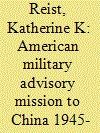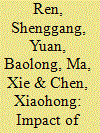|
|
|
Sort Order |
|
|
|
Items / Page
|
|
|
|
|
|
|
| Srl | Item |
| 1 |
ID:
125195


|
|
|
|
|
| Publication |
2013.
|
| Summary/Abstract |
The Pacific War ended in 1945 before the American government had established a plan for the implementation of its postwar goals for its relationship with China. Although China lacked unification, the Guomindang (GMD), the "allied" government, sought to create a more modern military along American lines, with American equipment, using American advisers and funding. GMD leaders did not want American influence or control, desiring to maintain their culturally organized structures and ways of functioning, including the use of guanxi (personal networks and favors). The Joint U.S. Military Advisory Group attempted to operate within this nexus of conflicting goals, purposes, and missions.
|
|
|
|
|
|
|
|
|
|
|
|
|
|
|
|
| 2 |
ID:
132695


|
|
|
|
|
| Publication |
2014.
|
| Summary/Abstract |
This paper employs the input-output (IO) approach to analyze the scale and structure of embodied carbon emissions of China×s 19 industry sectors during 2001-2011 and constructs a regression model to establish the relationship between energy intensity, per capita output, trade openness, foreign direct investment (FDI), trade comparative advantage, environmental regulation, technology, and CO2 emission intensity. Our results suggest that: China×s international embodied carbon emission balance has been in a state of continuous growth for the period 2001-2011, and China has become a pollution haven; the relationship between per capita output and CO2 emission is inverse N-typed and China×s industries are in the rising stage of the curve; FDI and trade comparative advantage are two main elements boosting China×s carbon emissions; trade openness, environmental regulation, and technology will lower the growth rate of China×s industrial carbon emissions (ICEs). Consequently, China×s policies should center on adjusting the industry structure and scale of FDI inflows, transforming industries with trade comparative advantages into a clean type, facilitating environmental regulation level, and bringing in and developing low-carbon technology to avert China from being a pollution haven.
|
|
|
|
|
|
|
|
|
|
|
|
|
|
|
|
| 3 |
ID:
138453


|
|
|
|
|
| Summary/Abstract |
When can non-governmental organisations (NGOs) affect government policies in a strong authoritarian Party-state like China? What is the status quo of state-society relations in China in the new century after decades of reform? Based on the literature of interest groups, state-society relations and civil society, this article builds and tests three hypotheses: the government-guided participation, NGO resource and vertical network. These hypotheses are tested through a quantitative study based on survey data. Findings have shown that the government-guided participation hypothesis is well-supported empirically, while the other two hypotheses have limited corroborating evidence. The Chinese political system is therefore still very much authoritarian and closed after more than two decades of reform and an “associational revolution”. It is also likely to follow a corporatist model instead of a pluralist model of state-society relations.
|
|
|
|
|
|
|
|
|
|
|
|
|
|
|
|
|
|
|
|
|